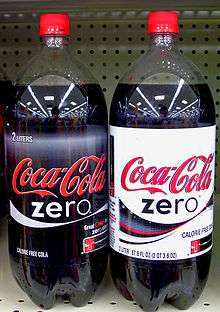Two-liter bottle

The two-liter bottle is a common container for soft drinks. These bottles are produced from polyethylene terephthalate, also known as PET plastic, using the blow molding process. Bottle labels consist of a printed, tight-fitted plastic sleeve. A resealable screw-top allows the contents to be used at various times while retaining carbonation.
In the United States, the two liter bottle is one of the few cases where a product is sold by a round number of metric units. Since very few other beverages are sold in this exact quantity, the term "two-liter" in American English almost invariably refers to a soft drink bottle. Other common metric sizes for plastic soft drink bottles include 500 milliliters, 1 liter, and 3 liters.
In many Eastern European countries such as Russia or Slovakia, plastic bottles are used for selling beer as well.
History
PepsiCo introduced the first two-liter sized soft drink bottle in 1970.[1] The bottle was invented by a team led by Nathaniel Wyeth of DuPont, who received the patent in 1973.[2] In 1985, a three-liter bottle appeared on supermarket shelves. The design is still used to this day by some bottlers.[3][4] Most modern-day two-liter bottles are one piece of PET (polyethylene terephthalate) with a base that is molded with a radial corrugation to provide strength for the bottom and the ability to stand upright. Most early two-liters had a separate opaque base glued to the hemispherical bottom of the clear PET flask. This base had a coaxial corrugation and drain holes. It was abolished in the 1990s, in part due to difficulties recycling the two separate plastics.
Recycling
Used two-liter bottles see new life in a variety of uses including carpeting, boat hulls, polyester fabric, filling for jackets, sleeping bags, mattresses, pillows, recycling bins, scouring pads, and on an increasing scale, new soft drink bottles.[5]
Specifications
Typical dimensions [6]:
- Height ~336 mm
- Diameter ~101.5 mm
Inventive uses
- Two two-liter bottles can be used to simulate a tornado by putting water in one and taping the mouths of the two bottles together in an hourglass fashion. Raising the chamber filled with water upright with a swirling motion initiates the vortex.
- A craze in 2006 involved putting Mentos mints into a 2-liter bottle of diet cola to produce a fountain effect (the Diet Coke and Mentos eruption).
- A dry ice bomb can be made from a two-liter bottle, water, and dry ice
- Water rockets often use a two-liter bottle. Fins are attached, the bottle is partially filled with water, and air is pumped in. On release, the air forces out a stream of water which propels the rocket.
- A dry ice water rocket can be made by filling a two-liter plastic bottle about one third with water, putting in some dry ice and forcefully inserting a #3 rubber stopper. Place the dry ice water rocket on its fins with the stopper pointing down or in a paper or plastic tube for firing like a mortar or bazooka. This dry ice toy amuses, but avoids the loud noise of a dry ice bomb that can often bring an unwanted police response.
- A funnel by cutting the bottle in half.
- A drinking vessel by cutting bottle in half.
- An impromptu bee or wasp trap can be created by cutting the bottle in half and inverting the top into the bottom half where soda remains or bait can be placed.
- The bottom portion of early two-liter bottles could be removed from its opaque base, cut off from the top portion, inverted and then reinserted into the base. If air holes were cut in it, this would create a small greenhouse or, if left uncut, a terrarium.
- An empty two-liter bottle sealed with its cap is sometimes used as a bobber for fishing.
- A simple trap for stickleback and other small fish may be made from a two-liter bottle, a one-liter bottle and a few odds and ends (string, tape, and a few inches of rebar or other metal rod).
- A subirrigation system can be created by cutting a plastic bottle in half and inverting the mouth into the bottom of the bottle. A piece of polyester or other synthetic fabric is placed in the mouth (to be used as a wick). Then, soil and a plant is placed above. The plant is watered by capillary action.
- Two-liter bottles are popular improvised targets for shooting practice, causing a spectacular reaction on impact without being too expensive.
- Use as a dispenser for plastic grocery bags. Cut off the bottom of the bottle, place bags (one at a time) into the bottle. Pull out one bag at a time from the neck of the bottle.[7]
- Many 3d-printed objects use soda bottles as components, attaching to them by their PCO1881-style threads.
See also
References
- ↑ "PepsiCo – Company – History". PepsiCo. 2006.
- ↑ Nathaniel C. Wyeth (Filed November 30, 1970, Issued May 15, 1973). "US Patent 3733309 Biaxially Oriented Plastic Bottle, via Google.com". Retrieved 2007-02-19. Check date values in:
|date=(help) - ↑ Maidenberg, H.J. (January 13, 1985). "PROSPECTS;Endangered Species". The New York Times. Retrieved May 26, 2010.
- ↑ "Alabama Business Hall of Fame to Celebrate 25th Anniversary". C&BA News. September 30, 1998.
- ↑ "Best Practices and Industry Standards in PET Plastic Recycling" (PDF). NAPCOR. 2003.
- ↑ http://www.mzbn.com/en/sales/information/. Missing or empty
|title=(help) - ↑ "Soda Bottle Plastic Bag Dispenser: 3 Steps". instructables.com.